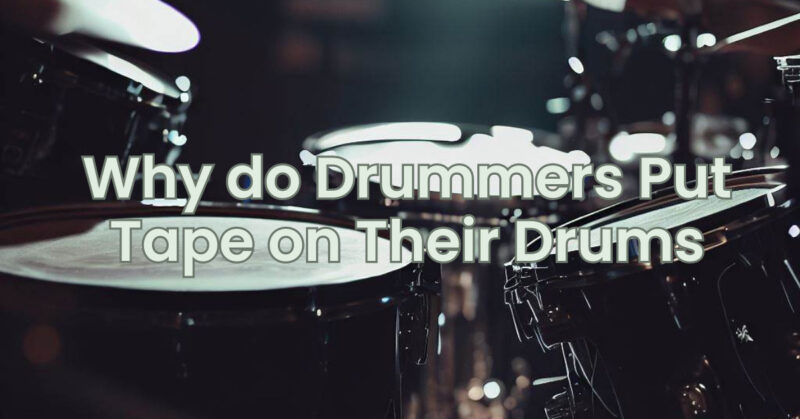If you’ve ever seen a drummer’s drum kit up close, you may have noticed strips of tape adorning their drums. Drummers often use tape as a practical and versatile tool to enhance their drumming experience. In this article, we will explore the reasons why drummers put tape on their drums, the benefits it offers, and the various techniques they employ.
- Dampening and Control of Resonance: One of the primary reasons drummers use tape on their drums is to control the drum’s resonance. By strategically placing tape on the drumhead, they can reduce unwanted overtones, sustain, and ringing. This dampening effect provides a tighter and more focused sound, making the drum easier to control in various playing situations. The tape acts as a temporary muffling solution, allowing drummers to customize the drum’s sound without permanently altering the drumhead.
- Tone Adjustment: Tape can also be used to adjust the tone of the drum. Different types of tape and placements can produce specific tonal characteristics. For example, placing tape closer to the drum’s edge can result in a slightly muted sound, while tape placed more towards the center can produce a drier, controlled tone. By experimenting with tape placement, drummers can fine-tune the drum’s sound to match their musical preferences or the requirements of a particular song or style.
- Reduction of Unwanted Overtone Frequencies: Certain drumheads or drum shells may produce unwanted overtones or frequencies that can interfere with the desired drum sound. Drummers use tape strategically to mitigate these issues. By experimenting with different tape placements and tensions, drummers can target and eliminate specific overtones, resulting in a cleaner and more focused drum sound.
- Protection and Durability: Tape can also serve as a protective layer for the drumhead. Drummers often apply tape in areas where the drumstick makes contact with the drumhead to prevent excessive wear and tear. This is particularly useful for drummers who use brushes or play styles that involve a lot of rimshots or rim clicks. The tape acts as a buffer, prolonging the lifespan of the drumhead and enhancing its durability.
- Visual Markers and Personalization: Some drummers use tape as visual markers to help with drum setup or to provide visual cues during performances. They may mark specific positions for drum placement or tape reminders for specific drum fills or accents. Additionally, tape can add a touch of personalization to the drum kit, allowing drummers to express their individuality and style.
Taping Techniques:
- Snare Drum Dampening: Drummers commonly use tape on snare drums to control resonance and dampen unwanted overtones. They may place strips of tape along the edge of the drumhead or experiment with different tape placements to achieve the desired sound. Additionally, some drummers apply a small piece of tape to the snare wires to reduce sympathetic vibrations and buzz.
- Tom and Floor Tom Dampening: Tape can be applied to the top and bottom heads of toms and floor toms to control resonance and eliminate unwanted overtones. Drummers often experiment with different tape placements and tensions to find the balance that suits their desired tone and playing style.
- Bass Drum Dampening: Tape can also be used on the bass drum to control resonance and dampen unwanted overtones. Drummers may place strips of tape on the batter head, near the edge or in the center, to achieve the desired level of dampening and focus.
Choosing the Right Tape:
When using tape on drums, it’s essential to select tape that is suitable for the task. Here are a few considerations:
- Gaffer’s Tape: Gaffer’s tape is a popular choice among drummers due to its strong adhesive properties and easy removal without leaving residue. It is also tearable by hand, allowing for easy customization.
- Electrical Tape: Electrical tape is another option commonly used for drum muffling. It is flexible, sticks well, and provides effective dampening.
- Drum-Oriented Products: Drum-specific products, such as drum muffling gels or pre-cut drum-specific tapes, are also available in the market. These products are designed specifically for drumming purposes and offer convenience and ease of use.
In conclusion, drummers put tape on their drums for various reasons, including dampening and control of resonance, tone adjustment, reduction of unwanted overtones, protection and durability, visual markers, and personalization. By using tape strategically, drummers can fine-tune their drum sound, achieve the desired tone and feel, and enhance their drumming experience. Experimentation with different tape placements and types will help drummers find the perfect balance and achieve the sound they seek.


